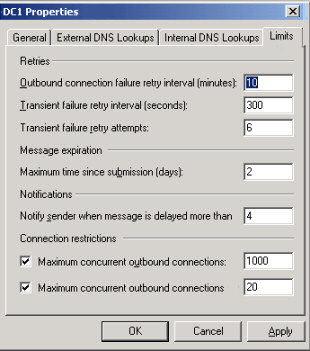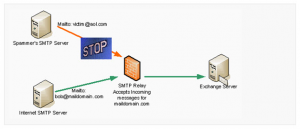

This is a default setting so the permissions on the Receive Connector have to be changed. However, only messages for recipients whose SMTP domain is an an Accepted Domain in the Exchange organization are accepted at this point. This command will create a new Receive Connector, bind it to the IP address 10.19.67.33 (this should be on the network card of the server of course) and allow the IP address 10.19.67.201 to submit SMTP messages anonymously. New-ReceiveConnector –Name “Relay Connector (EXCH01)” –usage Custom –Bindings 10.19.67.33:25 –FQDN –RemoteIPRanges 10.19.67.201 –Server ServerName –PermissionGroups AnonymousUsers To create the new Receive Connector use the following command in the Exchange Management Shell: This IP address can have an easy to remember FQDN like Of the four formats available, W3C Extended Log File Format provides the greatest choice of output. Exchange relies on IIS to provide protocol logging.
Exchange 2010 smtp relay upgrade#
This page is designed to help you understand SMTP logs. If you have the legacy free edition of G Suite, upgrade to Google Workspace to get this feature. I always recommend not to change the default receive connectors with the exception of setting Anonymous Users on the Permission Groups to allow other SMTP hosts to submit messages as well.įor relaying SMTP messaging I normally recommend to use an additional Receive Connector with an additional IP address on the server. Setup SMTP Auth in Microsoft Exchange 2010 To create the SMTP Connector, follow the steps below: In the Exchange Admin Console (EAC), navigate to Microsoft Exchange ->Organization Configuration->Hub Transport and then either right click in the open space and select New Send Connector or under 'Actions' on the right hand side, select New Send. SMTP Microsoft Exchange Server 2010 SMTP Logs. Default Receive Connector – used to receive SMTP messages on port 25 from other Exchange Hub Transport Servers or the Edge Transport Server.This is authenticated SMTP and the connector is using port 587 for this Client Receive Connector – used by end users with an SMTP client that want to send out messages.Enable the option to allow all computers that successfully authenticate to relay.When an Exchange 2010 Hub Transport Server is installed two Receive Connectors are automatically created: You want to choose "Only the List Below" so that only those IP's that are listed will be able to send through the server. This setting allows you to specify which IP addresses can relay. Next check the Relay settings on the SMTP server.

Exchange 2010 smtp relay windows#
Set the default domain to your internal Windows domain. However, using Basic and Integrated Windows authentication is ok. As with the IIS instructions above, Anonymous should NOT be enabled for Authentication. Folgen Sie ab dem Hauptmenü dem Pfad: Start> Alle. Open the Exchange Management Console, browse to the Server name, Protocols and locate SMTP virtual server. Wenn Sie über ein Microsoft Exchange 2007- oder 2010-Konto verfügen, müssen Sie in der Exchange-Verwaltungskonsole einen Sendeconnector konfigurieren, um turboSMTP als Exchange-Smarthost zu verwenden: Melden Sie sich bei Exchange 2010 an. If the server can't authenticate, then you will need to add their IP address to the list.Ĭheck your SMTP virtual server configuration.

While you could add the IP addresses of internal servers to the list, this is less safe and not recommended in most situtations. Enable the option to allow all computers that successfully authenticate to relay regardless of the above list is selected or your internal servers will be unable to send outbound mail. Choose "Only the List Below" to relay and only those IP's that are listed will be able to send through the server. Also set the default domain to your internal Windows domain.Īfter exiting the Authentication dialog, click on the Relay button. Using Basic and Integrated Windows authentication is fine. In Default SMTP virtual server, right click and select Properties, then the Access tab.Ĭlick the Authentication button. Hi, According to your description, I understand that.Display Name of the sender in Emails to mailboxes in on-premise is resolved correctly. The Externally Secured check box is checked. If you are using an IIS SMTP virtual server as an edge server, you'll check the authentication and relay settings on IIS. Dear All, We have SMTP relay receive connector in our on-premise Exchange 2010 server that accepts emails from anonymous users. More Information IIS SMTP Server settings If you need to allow a server to relay, you'll need to create a Receive Connector and allow relaying for that server's IP address. By default Exchange 20 are configured to only accept SMTP email for domains configured as authoritative and will only relay email to other domains for authenticated local users.


 0 kommentar(er)
0 kommentar(er)
